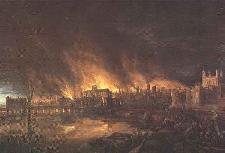September 2, 1666
It was a small mistake, but with great consequences. On September 2, 1666, Thomas Farrinor, baker to King Charles II of England, failed, in effect, to turn off his oven. He thought the fire was out, but apparently the smouldering embers ignited some nearby firewood and by one o'clock in the morning, three hours after Farrinor went to bed, his house in Pudding Lane was in flames. Farrinor, along with his wife and daughter, and one servant, escaped from the burning building through an upstairs window, but the baker's maid was not so fortunate, becoming the Great Fire's first victim. Did these cakes set fire to London? Or see Sir R Vinor's explanation to Pepys.
 The fire then leapt across Fish Street Hill and engulfed the Star Inn. The London of 1666 was a city of half-timbered, pitch-covered medieval buildings and shedsthat ignited at the touch of a spark--and a strong wind on that September morning ensured that sparks flew everywhere. From the Inn, the fire spread into Thames Street, where riverfront warehouses were bursting with oil, tallow, and other combustible goods. By now the fire had grown too fierce to combat with the crude firefighting methods of the day, which consisted of little more than bucket brigades armed with wooden pails of water. The usual solution during a fire of such size was to demolish every building in the path of the flames in order to deprive the fire of fuel, but the city's mayor hesitated, fearing the high cost of rebuilding. Meanwhile, the fire spread out of control, doing far more damage than anyone could possibly have managed.
The fire then leapt across Fish Street Hill and engulfed the Star Inn. The London of 1666 was a city of half-timbered, pitch-covered medieval buildings and shedsthat ignited at the touch of a spark--and a strong wind on that September morning ensured that sparks flew everywhere. From the Inn, the fire spread into Thames Street, where riverfront warehouses were bursting with oil, tallow, and other combustible goods. By now the fire had grown too fierce to combat with the crude firefighting methods of the day, which consisted of little more than bucket brigades armed with wooden pails of water. The usual solution during a fire of such size was to demolish every building in the path of the flames in order to deprive the fire of fuel, but the city's mayor hesitated, fearing the high cost of rebuilding. Meanwhile, the fire spread out of control, doing far more damage than anyone could possibly have managed.
Soon the flames were visible from Seething Lane, near the Tower of London, where Samuel Pepys first noted them without concern: